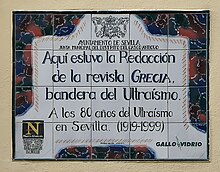Grecia (magazine)
 Commemorative plaque in Seville for the 80th anniversary of the ultraísmo manifesto in Grecia | |
| Editor | Rafael Cansinos-Asséns |
|---|---|
| Former editors | Adriano del Valle |
| Categories | Literary magazine |
| Founder | Isaac del Vando Villar |
| Founded | 1918 |
| First issue | 18 October 1918 |
| Final issue | November 1920 |
| Country | Spain |
| Based in | |
| Language | Spanish |
Grecia was a literary magazine which was published from 1918 to 1920 in Spain. Its subtitle was Revista Decenal de Literatura (Spanish: Decennial Literature Magazine).[1] Later it was redesigned as Revista de literatura (Spanish: Literature Magazine).[2] It was a traditionalist as reflected in its title[3] and modernist publication in the early years, but later adopted an avant-garde approach and became the flagship of the ultraísmo.
History and profile
[edit]Grecia was established by the Andalusian poet Isaac del Vando Villar in Seville in 1918 as a modernist literary magazine.[4] Its first issue appeared on 18 October 1918.[1] Adriano del Valle was the first editor-in-chief of the magazine which had 24 pages throughout its run.[4]
Although Grecia adhered to modernism, over time it covered the work by writers from distinct literary waves such as futurism, cubism, dadaism and expressionism.[4] The first manifesto of the ultraísmo group was published in the magazine in 1919.[5] The group included Guillermo de Torre, Rafael Cansinos-Asséns, Gerardo Diego and Jorge Luis Borges.[5] Following this incident Grecia became the leading media outlet of the avant-garde in Spain.[6] In addition, it played a significant role in the introduction of the ultraísmo in other Spanish-speaking countries, including Mexico.[5] Pedro Garfias published his poem Domingo (Spanish: Sunday) in the magazine which was a typical example of the ultraist poetry.[3]
The headquarters of Grecia moved to Madrid in the summer of 1920.[1][3] During this period Rafael Cansinos-Asséns edited the magazine. Its title page and header was redesigned by Norah Borges to reflect its avant-garde character.[1][7] The magazine folded in November 1920.[1]
References
[edit]- ^ a b c d e Vanessa K. Davidson (2009). "Norah Borges, the Graphic Voice of Ultraísmo in Two Peripheral Centres". Romance Studies. 27 (1): 13–15, 18. doi:10.1179/174581509X397993.
- ^ José Mª Barrera López, ed. (1998). Grecia: revista de literatura (in Spanish). Málaga: Centro Cultural de la Generación del 27.
- ^ a b c Zachary Rockwell Ludington (2022). "Spanish Ultraism's Sacred Woman of the Future". In Günter Berghaus; Monica Jansen; Luca Somigli (eds.). International Yearbook of Futurism Studies. Vol. 11. Berlin, Boston: De Gruyter. pp. 209–210, 215. doi:10.1515/9783110752380-009. ISBN 978-3-11-075238-0.
- ^ a b c "Grecia (Sevilla)". Hemeroteca Digital (in Spanish). 18 March 2024. Retrieved 14 April 2024.
- ^ a b c Vanessa Fernandez (2013). A Transatlantic Dialogue: Argentina, Mexico, Spain, and the Literary Magazines that Bridged the Atlantic (1920-1930) (Ph.D. thesis). University of California, Los Angeles. pp. 10, 88.
- ^ Kelly S. Franklin (Summer 2017). "A Translation of Whitman Discovered in the 1912 Spanish Periodical Prometeo". Walt Whitman Quarterly Review. 35 (1): 120. doi:10.13008/0737-0679.2267.
- ^ Eamon McCarthy (2015). "Flirting with Futurism: Norah Borges and the Avant-garde". In Günter Berghaus (ed.). International Yearbook of Futurism Studies. Vol. 5. Berlin; München; Boston: De Gruyter. p. 116. doi:10.1515/9783110422818-007. ISBN 9783110422818.
- 1918 establishments in Spain
- 1920 disestablishments in Spain
- Avant-garde magazines
- Defunct magazines published in Spain
- Defunct literary magazines published in Europe
- Defunct Spanish-language magazines
- Literary magazines published in Spain
- Magazines established in 1918
- Magazines disestablished in 1920
- Magazines published in Madrid
- Mass media in Seville
- Modernism
